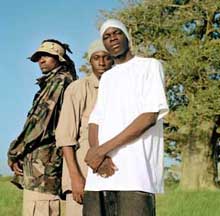A World of Rap
Marty Lipp talks with some of the movers and shakers of global hiphop.
Given the deadly internecine conflicts in rap, it seems reckless to raise another point of contention - that the genre's ancestry might stretch beyond the South Bronx. Two bands currently on tour in North America highlight hiphop's place in the world - first, that it is truly an international phenomenon, and second, that it may have not sprung full-blown from the blue sky and graffitied walls of the Bronx.
 Aladji Man, Faada Freddy, N'Dongo D
Aladji Man, Faada Freddy, N'Dongo D
|
Faada Freddy of Senegal's Daara J said that when he first heard Grandmaster Flash's "The Message," he was not only blown away by the medium and the message, but was convinced that it was blood relation to the traditional Senegalese style called tasso.
"I believe strongly," he said, "that the music was slumbering in the soul of Afro-Americans and one day it just got awakened."
He said that tasso, which can be accompanied by clapping or drumming, has always been a vocal style that commented on society, like Daara J's own rapping. "We're just like cameras out on the street," he said.
The group's CD, Boomerang (Wrasse), refers to the belief that rap was born in Africa, then went out into the world and came back. Daara J brings its Senegalese hiphop to NYC's Avery Fisher Hall at Lincoln Center, where it opens for Wyclef Jean on July 14th.
Freddy said that when American rap first broke out in Senegal, he and others began imitating the style, but eventually began writing songs in their own languages, adding elements of traditional music and dealing with their own social and political situation.
He added that gangsta rap is wholly inappropriate for Senegalese listeners. Gangsta rap, he said, is "just trying to keep the people dreaming and to make profit on that gangsta image."
"We're from Africa," he continued. "We're from a poor country. We know the misery. We know the hunger. We know the revolution. We know about love as well. This is our reality and that's what we try to deal with."
 Lúcio Maia
Lúcio Maia
|
Similarly, Lúcio Maia of the Brazilian group Nação Zumbi was stunned when he first head Public Enemy in his poor hometown of Recife, but he said that gangsta rap, with its talk of big cars and bling-bling jewelry, is too far removed from Brazil's widespread, deep poverty. "Here, it's houses made of paper, a really [screwed up] place to live."
Northeastern Brazil also has a traditional vocal rhyming style, called embolada, that seems a close kin to rap. Embolada has remained local, Maia said, because it is from such a poor, overlooked area.
Nação Zumbi melded rap, metal and rural styles from the northeast of Brazil in a powerfully percussive hybrid. The group lead the "mangue beat" movement in Recife, which had been considered a cultural backwater. Unfortunately, as Nação Zumbi's star was ascending, the group's charismatic leader, Chico Science, died in a car accident.
Science's death was a devastating blow to the group, Maia said, since he was its creative leader. With his loss, the group members had to learn to follow their own artistic impulses, instead of taking their cues from Science. Thirteen years ago, the group scraped some money together to finance its own international tour, making its U.S. debut at Central Park Summerstage in NYC.
It's understandable that we want to know just who fathered the international success that is hiphop, but to dwell too intently on its past is to ignore its present, which is rapidly evolving, here and around the world. - Marty Lipp
|



